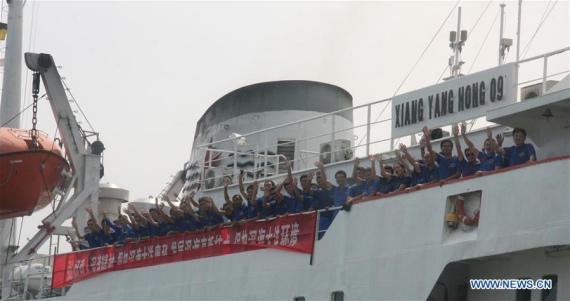
Members of the expedition team wave hands on Xiangyanghong 09, carrier of China's manned deep-sea submersible Jiaolong, in Qingdao, east China's Shandong Province, July 13, 2016. (Xinhua/Zhang Xudong)
Chinese deep-sea manned submersible Jiaolong came back to its home port in Qingdao on Wednesday after a scientific expedition lasting nearly 100 days to the Yap Trench and Mariana Trench in the west Pacific Ocean.
During the 94-day-expedition, the submersible dived to depths of up to6,796 meters where it acquired substantial geological, biological and deep water samples and took high definition videos.
This is the second time Jiaolong has dived below 6,000 meters in the sea. In 2012, it ventured down to 7,062 meters, the deepest an operation-type submersible has ever reached.
Very little is known about life, the environment and geological conditions so deep in the sea due to limitations in technology enabling its exploration.
"Jiaolong's expedition has brought back first-hand materials for Chinese scientists to contribute to sea abyss studies," said Peng Xiaotong, chief scientist at the Institute of Deep-sea Science and Engineering under the Chinese Academy of Sciences.
During its deep sea exploration, Jiaolong found an active mud volcano on the south slope of the Mariana Trench and shot videos. It also took samples from another mud volcano at the trench's north slope.
It also found that organisms dwelling at the bottom of two seamounts in west Pacific to be largely similar. Such findings will serve as valuable references to the design of deep sea mining, according to Wang Chunsheng, a researcher with the State Oceanic Administration.
Jiaolong also found continuous distribution of cobalt-rich crust in the deep sea area, helping inform China's future decisions in identifying areas for prospecting.


















































